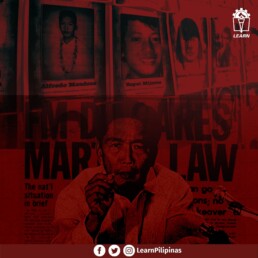Need To Explain? Political Dynasties
Kalakaran ang mga magkakaanak sa pulitika sa Pilipinas. Hindi ito bagong problema, pero sa takbo ng panahon, mas lumalim ang kapit ng iilangangkan sa bansa natin.
Noon, mayroong dalawang antas pa lang ng political dynasty: 1) Thin, ang isa-isa o nagsasalitan na mga magkaanak sa piling posisyon sa gobyerno, at; 2) Fat kung saan iilang miyembro ng pamilya ay nasa iba’t ibang posisyon sa gobyerno. Ayon kina Mendoza, Jaminola, at Yap sa kanilang papel, halimbawa ang Pilipinas ngayon sa mas malalang antas ng political dynasty, ang obese: Higit sa limang miyembro ng pamilya ay sabay-sabay na nakaupo sa gobyerno. Karaniwan sa atin na nasa lokal (probinsya, munisipyo, barangay) ang base ng kapangyarihan ng mga pamilya, at habang tumatagal magkakaroon sila ng mas malaking pagkakataon na makapasok din sila sa mga posisyong pambansa o national.
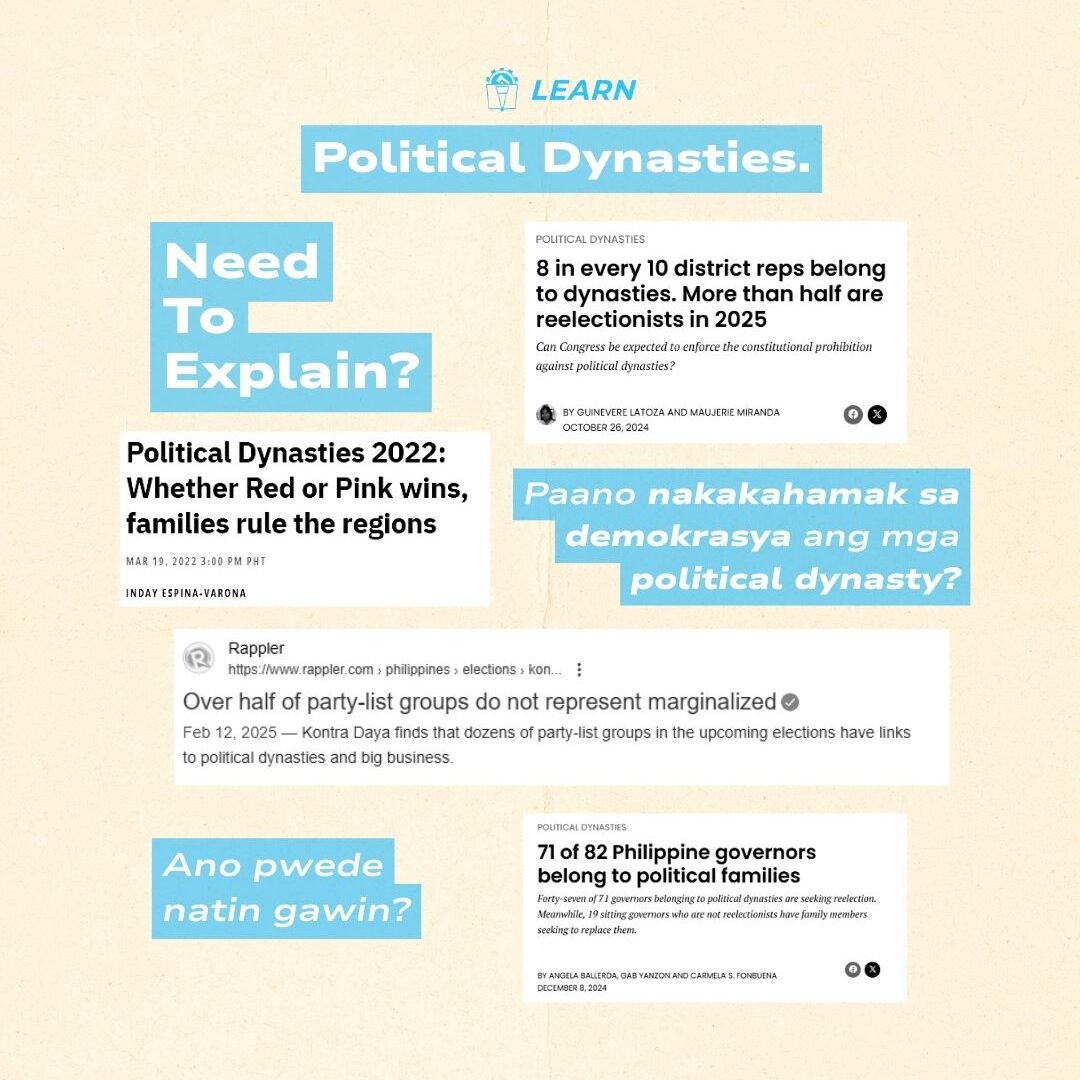
Paano nakakahamak sa demokrasya ang mga political dynasty?
Naiipon sa apelyido nila ang kapangyarihan at kasangkapan upang maging padron: May kapangyarihan sila mamili kung kanino mapupunta ang mga pampublikong serbisyo, na magdesisyon kung saan ilalaan ang pondo mula sa buwis ng manggagawa’t mamamayan, kung ilalaan ito sa ayuda o sa iba’t-ibang personal na programa.
Sa isang lipunang laganap ang kahirapan at kawalang katiyakan, ang “politikang ayuda” ng mga angkan at trapo ang isa sa kanilang mga instrumento upang manatili sa kapangyarihan. Mauulit-ulit ang kanilang pagiging padron lalo na’t namimigay sila ng pansamantalang tulong o ayuda na may tatak ng angkan nila, kahit galing ito sa kaltas sa sahod natin o sa patong na buwis sa mga bilihin.
Imbis na serbisyo ng gobyerno, pinaparating nila na ito ay mula sa kanilang kabaitan. Halos sinasabi na kung mawala sila sa posisyon, mawawala na rin ang ayuda na sa totoo ay kaltas sa ating buwis. Sa ganitong paraan nawawasak ng politikang ayuda na sanhi ng political dynasties ang demokrasya. Ang pagboto at pagserbisyo ay nauuwi sa sino ang kaya magbigay, hindi kung ano ang laman ng programa ng mga kumakandidato.
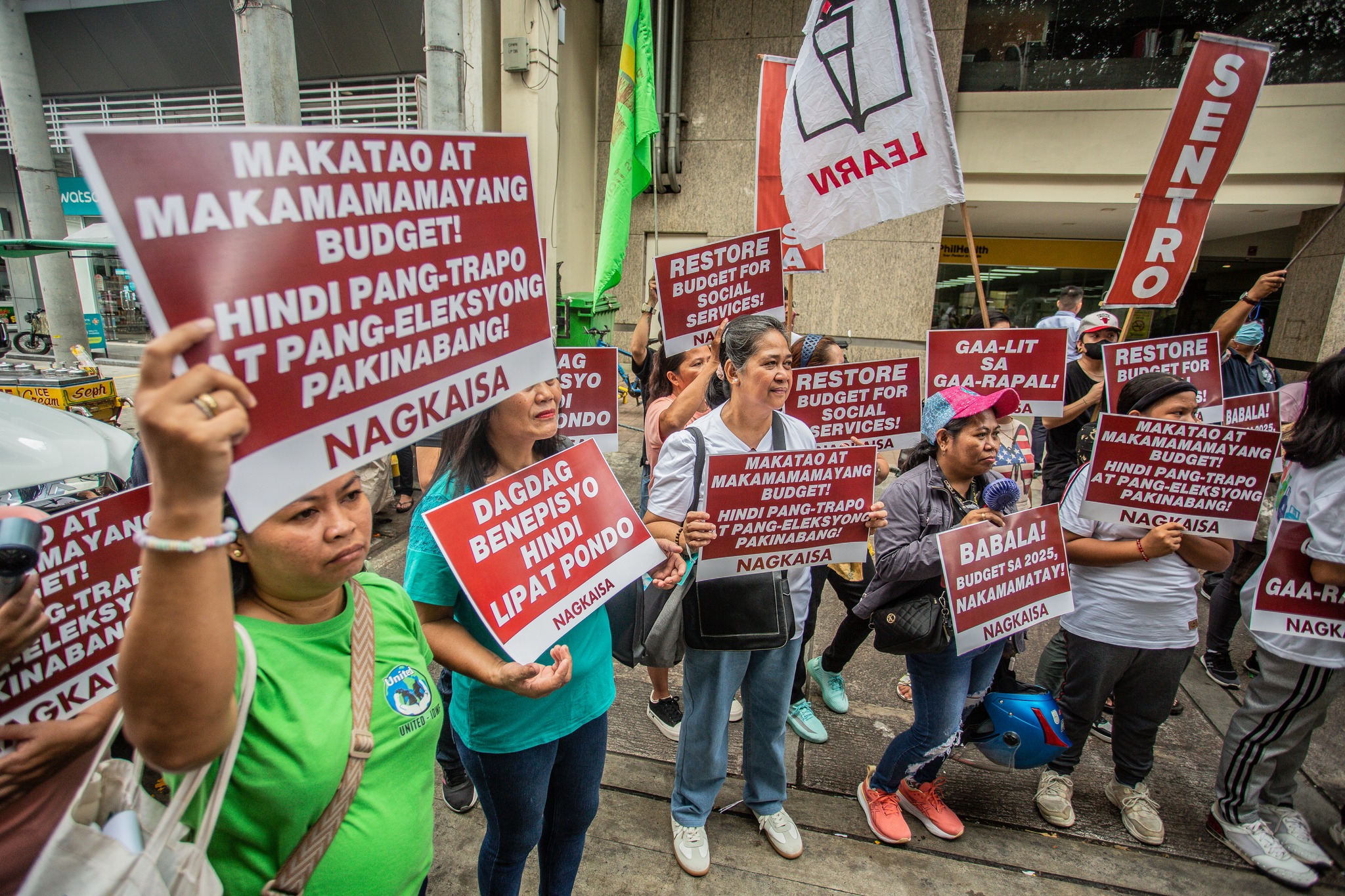 Protesta ng SENTRO laban sa Zero Subsidy sa PhilHealth sa ilalim ng 2025 Budget.
Protesta ng SENTRO laban sa Zero Subsidy sa PhilHealth sa ilalim ng 2025 Budget.
Ano pwede natin gawin?
Sa darating na eleksyon, tayo’y bumoto base sa agenda ng manggagawa at ituloy natin ang pagbuo ng ating labor vote. Gamitin natin ang ating lakas bilang kilusan sa pagpapasok ng mga kampeon ng mga karapatan ng manggagawa sa gobyerno. Tayo’y nanaliksik at bumubuo ng mga mungkahing legislasyon para solusyunan ang mababang sahod, ang mataas na inflation, ang kawalan ng seguridad sa trabaho. Siguraduhin nating may makikinig sa boses natin bilang manggagawa, na may mananagot sa ating mga hinaing. Ipanalo natin ang mga kandidatong tutulong ipanalo rin ang ating agenda.
Gayundin, di mawawala ang mga problema natin sa isang eleksyon, o sa paghahanda para sa susunod. Ipatuloy ang gawain sa kilusang paggawa sapagkat nabubuhay ang demokrasya sa aktibong partisipasyon ng mga mamamayan. Ito ay pawang karapatan at tungkulin ng bawat Pilipino. Hindi natatapos ang ambag natin sa bansa sa eleksyon. Alalahanin natin na tayong mga manggagawa at mamamayan ang nagpopondo sa gobyerno, at kailangan nating siguraduhing nagagamit sa tamang paraan ang bunga ng ating marangal na paggawa.
Sanggunian:
Mendoza, Ronald U. and Jaminola, Leonardo and Yap, Jurel, From Fat to Obese: Political Dynasties after the 2019 Midterm Elections (September 1, 2019). ATENEO SCHOOL OF GOVERNMENT WORKING PAPER SERIES, September 2019, 19-013, Available at SSRN: https://ssrn.com/abstract=3449201 or http://dx.doi.org/10.2139/ssrn.3449201
Mga artikulo sa litrato:
- Espina-Varona, I. (2022, March 19). Political Dynasties 2022: Whether Red or Pink wins, families rule the regions. RAPPLER. https://www.rappler.com/philippines/elections/overview-political-dynasties-series-2022-polls/
- Fonbuena, A. B., Gab Yanzon, Carmela S. (2024, December 8). 71 of 82 Philippine governors belong to political families. PCIJ.Org; Philippine Center for Investigative Journalism. http://pcij.org/2024/12/08/governors-political-dynasties-philippines-provinces-elections/
- Miranda, G. L., Maujerie. (2024, October 26). 8 in every 10 district reps belong to dynasties. More than half are reelectionists in 2025. PCIJ.Org; Philippine Center for Investigative Journalism. http://pcij.org/2024/10/26/lower-house-district-representatives-political-dynasties-reelection/
- News, G. I. (2025, February 12). 55% of party-list groups don’t represent marginalized sectors — Kontra Daya. GMA News Online. https://www.gmanetwork.com/news/topstories/nation/936006/55-of-party-list-groups-don-t-represent-marginalized-sectors-kontra-daya/story/
Workers versus Heat: Demanding Hazard Pay for Health
Kiko, a platform rider, worker aged 42, lamented, “Summer in Manila has never been this hot.” With temperatures soaring to an off-the-charts 47 degrees Celsius, this past summer is not just a record-breaker; it’s a sign of even hotter days ahead, as scientists warn that this could be the “coldest” we will experience.
As the planet warms and technology reshapes our lives, it is the workers in the gig (or platform) economy feeling the heat. Kiko is among the 400,000 platform workers in the country, as reported by Fairwork Philippines. Most of platform workers do not have social insurance (SSS or Philhealth) because of the nature of their employment. They earn their living on a day-to-day basis. Hence, they can’t hit pause or seek shelter just because it’s a scorching 47 degrees outside.
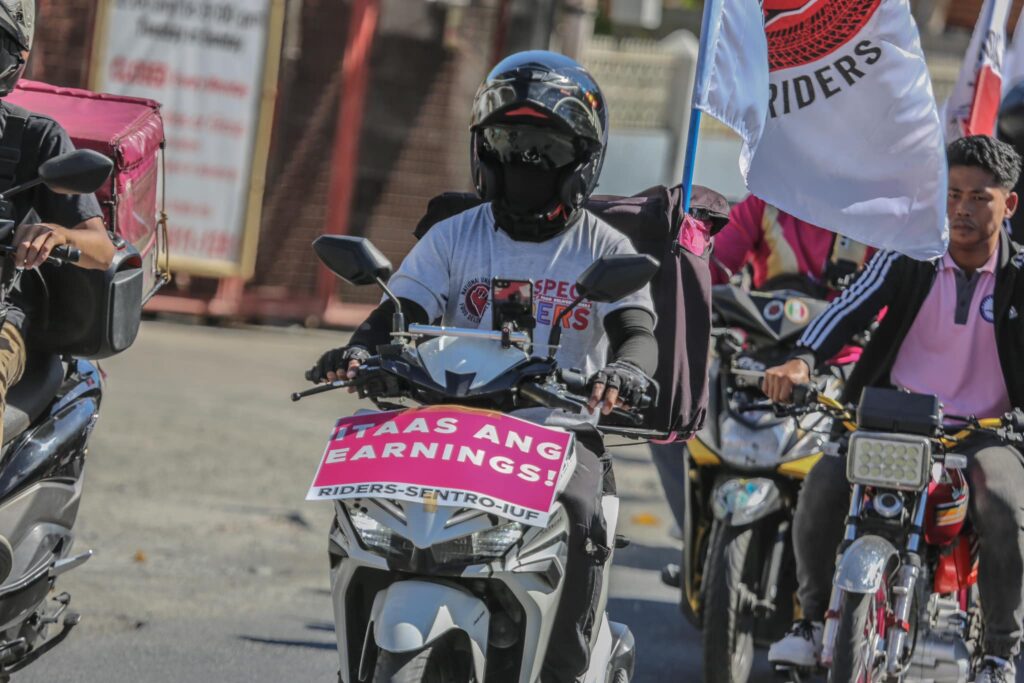 Photo Courtesy of RIDERS-SENTRO
Photo Courtesy of RIDERS-SENTRO
The Heat Index: More Than Just Numbers
When asked about the heat index, Kiko said “It might be 36? But it feels like 47!”, yet it matters to who? Work does not stop at 36 or 47.
The impact of heat varies, inversely tied to social class. The working class bears the brunt under the blazing sun, while the middle class can seek refuge with SPF 50 and a cool drink. As for the elites, they fly out to milder climates at will.
To announce suspensions due to extreme heat indicates intolerable conditions that disrupts daily tasks. For schools with roofs and AC units, they have suspended classes multiple times in the past dry season, prompting some cities to consider heatwave signals akin to typhoon warnings.
Yet, heat, like storms, doesn’t discriminate. Extreme weather affects everyone’s physiology, regardless of social standing—and this is a basic argument for workers to demand better working conditions.
A study on risk perception of heat among workers even warningly says that workers perceive heat stress lowly, that contributes to occupational heat stress as a risk factor for serious medical conditions.1 In July 2023, five people died in Italy while working under the heatwave. This forms part of the 61,000 deaths due to the European heatwave that is projected to dial up year after year.2
Kiko says, “to pause and seek some shade to cool down helps a little, but to do work stoppage and not seek delivery orders does not help us at all.” Like a planet that heats up, jobs for delivery riders like Kiko has no option B.
Climate Crisis as Work Hazard
Heatwaves, along with other extreme weather conditions, signify a climate emergency and justify demands for hazard pay. Just as frontline workers were compensated during Covid-19 crisis, those enduring the climate crisis’ extreme heat deserve recognition and compensation. But who foots the bill?
Some companies provide basic relief, like cold water for transport workers and shaded rest areas for construction crews. However, the costs of heat-related illnesses (like heat rash, spasms, and heat stroke) aren’t put into paychecks.
Other countries have set-up compensation measures for work interruptions during dangerous levels of heat. The Austrian government has approved a collective bargaining agreement with its federation of construction workers to allow work stoppage for heat of above 32.5ºC with 60% compensation during the work stoppage period.3 France has an inclement weather leave fund for workers in the construction industry;4 Germany’s IG BAU—in a CBA with roofing industry workers—compensates up to 53 hours of salary if roofing workers are unable to work due to weather conditions such as extreme heat;5 In Italy, when employers declare perceived heat more than 35ºC, they can avail of their unemployment scheme protection, and is also applicable if a worker is laid-off due to inclement weather.6
The Costs Have Escaped, The Heat Will Not
Meanwhile, in the Philippines, the Department of Labor has issued a guideline for private sector workers on work suspension due to bad weather.7 But for platforms workers like Kiko, the private sector has none or minimal interventions due to its informal type of agreement with its workers. For farmers and other agricultural workers, they could literally farm to death with this dangerous heat, and no business intervention would be there to save them.
While the mentioned countries are developed economies, a climate finance scheme is actually available for developing countries, especially for informal and platform workers.8 The Philippine government, in Kiko’s behalf, can argue that workers incur loss and damages due to heat and that corporations are liable to this.
Absent of this loss and damage framework, corporations would only charge the health hazard pay to consumers and escape their cost of heating up the planet. The alt-right would then blame workers for higher cost of goods—a time-tested cost-escaping strategy of corporations. All this happening while the heat they have produced does not escape the atmosphere and only goes back to us. To put a house on fire and then walk away like nothing happened is arson. Those who contributed to this global arson should actually pay its price and not add more fuel to this burning planet.
US Senator Bernie Sanders rightly pointed out how the alt-right propaganda puts the battle among workers vs consumers instead of uniting the people versus corporate greed and the climate crisis. Workers should not be afraid to demand a health hazard pay for taking the heat. Consumers should not blame workers who deliver their lunch in their air-conditioned buildings. Instead, consumers should take on this heat with workers and demand for a health hazard pay.
Whether in the perspective of suspensions or heat-indices, this heat is an occupational hazard. Workers deserve a compensation to this health hazard—and carbon corporations should pay for it. Not Kiko, not you.
Notes
1 Bonafede, M., Levi, M., Pietrafesa, E., Binazzi, A., Marinaccio, A., Morabito, M., Pinto, I., de’ Donato, F., Grasso, V., Costantini, T., & Messeri, A. (2022). Workers’ perception heat stress: Results from a pilot study conducted in italy during the covid-19 pandemic in 2020. International Journal of Environmental Research and Public Health, 19(13), 8196.
2 Limb, L. (2023, July 24). Heat stress: How can we save workers from a ‘silent killer’? Euronews.
3 Building and Wood Workers’ International. (2024). Adapting to the Heat: Existing Global Responses for Workers in Construction, Building Materials, Wood, and Forestry Industries (p. 44). Building and Wood Workers’ International.
4 Proposition de loi, 1587, 16e législature (2023).
5 Building and Wood Workers’ International. (2018, November 9). New agreement gives wage increase to German roofing workers. Building and Wood Workers’ International.
6 Italy readies special furlough scheme to save workers from heatwave. (2023, July 25). Reuters.
7 Patinio, F. (2022, August 25). DOLE issues guidelines on work suspension due to bad weather. Philippine News Agency; Philippine News Agency.
8 Protecting People from Extreme Heat: 10 Steps for Governments to Address Human Rights Impact of Climate Crisis. (2022, July 21). Human Rights Watch.
Can You Raise Your Flag in Japan?
The day was April 29, 2023, the start of Golden Week celebrations, on a sunny but still tolerably cool day in Nagoya City. I was running around the open space of the South Exit of Kanayama Station as a volunteer for the Philippine Friendship Festival (PFF). This event was returning for the first time since it was canceled in 2020 and throughout the COVID-19 pandemic. Sponsored by the Chubu-Philippine Friendship Association (one of the major volunteer groups engaging Filipino migrant communities throughout Central Japan), the event hosts multiple cultural presentations, Filipino food businesses, money exchange and transfer kiosks, as well as tourism booking booths. It’s an opportunity for Filipinos to meet each other, and promote Filipino places and points of pride to swarming Japanese crowds. I mostly assumed this was going to be my main concern for the day.
Something in the corner of the open space, however, caught my eye.
I encountered a handful of activists staging an impromptu call to action together with a mobile exhibit. Carrying posters, photos of protest actions, and political events, I realized the activists were members of Kenkoro (建交労, the All-Japan Construction and Transportation General Labor Union) protesting the government’s continuing subversion of Article 9 as well as campaigning for greater social spending.
Realizing that they were labor activists, I tried to converse with them—I with my limited Japanese and they with limited English. We were both pleasantly surprised to discover our connections—they are affiliates of Zenroren (the national Japanese labor movement) while I was a former labor center staff of SENTRO (a Filipino labor center that has had long-standing solidarity projects with Zenroren). They shared that Filipinos are among the well-known migrant workers in their fields and throughout this region, and were thankful to find someone like me who is sympathetic to them. They also reminded me of the occasional protest actions my activist friends, mentors and even former students staged when issues pop up. They tend to be a motley crew of no more than ten- or twenty-people holding placards, desperately gathering attention or trying to provoke a public response, with little success.
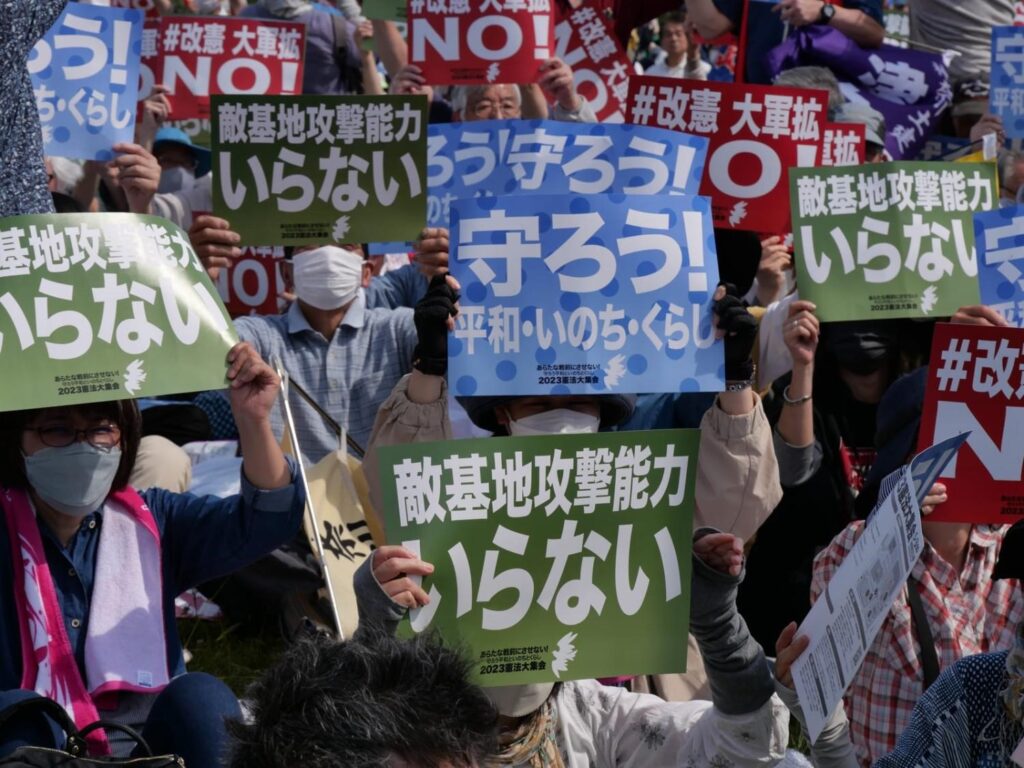
I did have to return to my volunteer work at PFF for the rest of the day (and they wrapped up not long after I left). That said, meeting them became an ongoing point of reflection for me since that day. I thought it quite sad that not only activist action here in Nagoya doesn’t seem to garner as much traction, but it seems to be a phenomenon wherever in the country. This is not to say that protest action in Japan in general remains unpopular or flat-out frowned upon—at least, not as much anymore. As discussed by Carl Cassegård in his 2022 article on the rebirth of Japanese protest movements, the twin factors of a) landscape changes that destabilized traditional Japanese politico-cultural regimes, coupled with b) the persistence of niche activist spaces that sustained progressive political attitudes even as they remain unpopular, are instrumental to reinvigorating civil society engagement.1
This is important considering Japanese civil society’s long sluggishness since the heyday of the Anpo (anti-US-Japan Security Treaty) in 1960 and the demise of the New Left in Japan in the 1970s. For the most part, protest action in Japan tends to mostly gain traction with the national audience if it involves three factors. The first would be if it is in response to monumental urgent issues like those in the aftermath of the 2011 triple disaster in Fukushima, the 2018-2019 protests against the corruption of prime minister Shinzo Abe (who was assassinated later), and the holding of Olympics in 2020. The second would be if the ones mobilizing are parts of minority communities pushing for integration/protection in Japanese society (such as those representing Zainichi Korean communities and the more recent #BlackLivesMatter Tokyo). Third, and perhaps more importantly, if the issues involved are covered globally and affect Japan’s international relations such as the ever-contentious Article 9 and the US bases in Okinawa.

Then again, maybe this is the core-periphery politics of many modern nations at work. Nagoya City, only recently catching up to the level of international attention and politico-economic significance of Japan’s other major urban centers (like Tokyo Metro and Osaka), exhibits the same challenges gentrified cities have when it comes to fostering more activist political participation. The consciousness or willingness of people to be part of a “community of fate” that would mobilize them towards open engagement remains alien to popular Japanese consciousness—booted and stigmatized as it was during the boom economic years before the bubble of the 1990s. Hence, it’s a bit unfair to expect it to sustain the same level of monumental activist changes that may be more visible in Tokyo Metro. The situation tends to affect civic and organized groups in general regardless of ideology, as not even the more conservative and right-wing mobilizations (such as uyoku dantai and anti-vaxxer groups) tend to garner enough boots on the ground either.
This brings me back to something I was directly tied to: the Filipino communities in Central Japan. While being part of volunteer and cultural exchanges is one thing, it’s another thing to ask about Filipino activism in Japan. If Japan in itself is still struggling with fostering more open and engaged spaces for Japanese of all ages to express their dissatisfaction and dissent at how their country is run, how does the Filipino diaspora figure in these niches? Should we agitate and engage? Should we reach out by means of international solidarity? Or do we keep to ourselves until our problems become big enough that it has to be aired out in the open? For that matter, to what extent are we actually seeking to engage and educate, or to merely “find our own”?
The answer, if my own experience of Filipinos’ engagement with the 2022 national elections back in the Philippines is any indication, depressingly suggests the latter.
Hansley A. Juliano is an LRI fellow engaged in writing about civil society & social movement history, as well as labor policy strategies. He is also a returning Lecturer of the Department of Political Science, Ateneo de Manila University. He is currently finishing his Ph.D. in International Development at the Graduate School of International Development (GSID), Nagoya University.
1 Carl Cassegård (2023), “The recovery of protest in Japan: from the ‘ice age’ to the post-2011 movements,” Social Movement Studies, 22:5-6, 751-766, DOI: 10.1080/14742837.2022.2047641.
Labor Day 2023: A call to organize
Today, we at LEARN join workers of the world in celebrating May 1. This Labor Day, we remember the sacrifices of countless women and men who have fought for workers’ rights, better wages and benefits, and humane treatment in the workplace.
Our movement started in the 1840s when workers and unions fought back against the wielders of capital who forced our forebears to work at all hours for a pittance. The idea of the right to rest and decent wage—and of acting collectively—caught like wildfire. Millions of overworked and underpaid people in many parts of the world embraced and joined the movement.
In 1889, at the Second International, a congress of socialist groups and trade unions designated May 1 as a day to commemorate the Haymarket Riot. Three years earlier, on May 4, 1886, police and labor protesters had a violent confrontation in Haymarket Square, Illinois, Chicago. The Haymarket Affair became a symbol of the international struggle for workers’ rights.1
Our history is the story of unions improving our lot as workers. Our history is the story of humanity freeing ourselves from the shackle of exploitation.
Modern trade unions can be traced back to 18th Century Britain, when the industrial revolution started to attract peasants and immigrants into cities. Although Britain had ended serfdom earlier in 1574, most people remained as tenants that “work” on vast tracts of lands owned by the aristocratic class. But the industrial revolution created a new class of "workers" who owned nothing in the implements of production.
At least, farmers who paid rent to the land’s owners retained some control over their produce and by extension, their lives. They were able to sell animal products they raised and crops they tended. Industrial workers, on the other hand, only had their own labor to sell; they lost autonomy when they traded their sweat in exchange for wages.
Compelled by their hardships, unskilled and semi-skilled workers spontaneously organized, starting as small groups. Capitalists and governments, who were either former aristocrats or their representatives, prosecuted the struggling workers.
Unionism arrived in the Philippines by way of the national liberation struggle towards the end of Spanish colonialism 1898. After his exile in Spain, nationalist leader Isabelo de los Reyes returned to the Philippines in 1901 and founded the first labor union federation in the country in 1902: the Unión Democrática de Litógrafos, Impresores, Encuadernadores y Otros Obreros or the Democratic Union of Lithographers, Printers, Bookbinders, and Other Workers.2
But even as early as the 1850s, Filipinos have formed secret workers’ guilds (or gremios) that acted for the mutual benefit for its members. These guilds would later become the backbone of trade unionism in the country.
As in other countries, trade unionism in the Philippines has a revolutionary and anti-colonial tradition. That tradition was responsible for securing a long list of benefits for the workers that include: shorter working hours, minimum pay, 13th month pay, paid leaves, maternity leave, allowances, rest breaks, collective bargaining (which introduces new and better benefits), and many others.
Today, trade unionism in the country faces a multitude of challenges—among them is the declining number of organized workers.
In the 2019/2020 Integrated Survey on Labor and Employment, the PSA reported that the proportion of union members to total paid employees recorded a dismal 6%, a decline from the 7% reported in 2018. Only 316,458 of the 5.29 million paid employees are unionized workers. Declining union density has been a trend for many years now. Also, in 2020, the proportion of employees covered by CBAs to total paid workers was only 6.3% or 333,776 of the 5.29 million.
The context is: Of the 113 million Filipinos (2020 census), 48 million are supposedly working.3 But government data itself show that only close to 5 million workers are paid in formal establishments, and of these paid workers, not even half a million are unionized and enjoy better benefits.4 A number factors contribute to low union density:
One, a huge chunk of establishments in the country are small, employing less than 10 workers who can be easily dissuaded by the owners from forming unions.
Two, contractual workers are unable to join unions as they are dismissed every five months.
Also, the Philippine economy, propelled by technological advances and new needs, is generating jobs outside of the familiar establishment-based employment. Among them are domestic workers and e-platform-based workers such as delivery riders.
Three, the country has a huge informal sector. They are small-scale producers and distributors of goods and services, who under the Constitution and the Labor Code, must be covered by social protection, as they are also regular consumers of goods and services, and therefore contribute taxes. But before they can enjoy these rights, they needed to be organized first.
To sum up, workers covered by the protection of unions and CBA are small because many Filipino workers are outside of the usual establishments, which therefore could not be accommodated under the familiar form of unions patterned from the European and American models.
Our huge informal sector should force us to organize in ways outside current norms.
Finally, the Philippine labor movement is small and splintered into smaller groups. It is unable to mount collective bargaining with their employers and the government.
Let us view these challenges as opportunities.
The small can only grow big. The call of the time is to organize.
1To distance from the socialist theme, then U.S. President Grover Cleveland in 1894 designated the first Monday of September as Labor Day in the United States.
2De los Reyes, a big landlord but an anti-colonial leader, was jailed and exiled to Spain. Later he also actively sought independence from the United States.
3See https://psa.gov.ph/content/employment-rate-february-2023-estimated-952-percent.
4See https://psa.gov.ph/press-releases/id/167868.
References
Tomich, Dale W. (2004). Through the prism of slavery: labor, capital, and world economy. Lanham: Rowman & Littlefield.
Amante, Maragtas S.V. (2019). Philippines Unionism ― Worker Voice, Representation and Pluralism in Industrial Relations, Institute of Developing Economies, Japan
Guevarra, Dante G. (1991). History of the Philippine Labor Movement. Sta. Mesa, Manila: Institute of Labor & Industrial Relations, Polytechnic University of the Philippines
Martial Law @50: Continuing quest for social justice and freedom from poverty
The maturity of a nation, it has been said, can be gleaned from how its people treat its painful past -- with brave acceptance of what happened and a strong conviction to prevent it from happening again.
However, an overwhelming number of Filipinos (31 million) have recently decided that the pain the country suffered during the dark years of martial law is no reason to prevent the election of the son and namesake of its perpetrator. And this after the election of Rodrigo Duterte, who exceeded the elder Marcos in brazen violence. Many have tried to come up with a suitable description for the behaviour: collective amnesia, social denial and dissonance, masochism, even sheer stupidity.
Exactly 50 years ago on September 23, 1972, the ousted dictator Ferdinand Marcos Sr. announced on television that he had signed Proclamation No. 1081 earlier in September 21, putting the Philippines under military rule.
That regime would last for ten gruesome years, with waves of torture, extrajudicial killings, and other appalling human rights violations against ordinary citizens. Amnesty International estimates that about 70,000 people were imprisoned, 34,000 were tortured, and over 3,200 were killed outright.1 Hundreds of desaparecidos, people who were abducted by state actors, were never seen again dead or alive by their families and loved ones.

Marcos apologists and paid trolls however are quick to point out that these atrocities are necessary payment for the economic “golden age” at that time. The purported golden age however is a methodical disinformation, churned into chewable fake news and used effectively in May 2022 election.2
From 1972 to 1985, the average annual gross domestic product (GDP) growth rate was 3.4 percent, and the per capita GDP grew every year by less than 1 percent. In contrast, the average annual GDP growth from 2003 to 2014, despite the political chaos, was 5.4 percent.3
But why would such a thing happen under the watch of a brilliant Marcos? Because the economy under him was suffering from a post-war recession and the response was largely to secure foreign loans that financed ambitious big-ticket projects with huge percentage of kickbacks going to his cronies that eventually ended in his own pocket. With debt as foundation, that economy started to tumble like a house of cards in 1982, crashing in 1985 when the government could no longer pay its debt obligations.4 And just like what recently happened in Sri Lanka, what ensued was debt crisis, unemployment, untold poverty, and even famine.
For many of the surviving victims of Marcos’s martial law and their loved ones, justice and reparations remain incomplete. On February 25, 2013, the late former President Benigno “Noynoy” Aquino III signed the Human Rights Victims Reparation and Recognition Act, or Republic Act 10368, which created the Human Rights Victims’ Claims Board. When the claims board ended in 2018, it received over 75,000 claimants. Unfortunately, the board assessed that only around 11,000 fully met the requirements to claim reparation, which was sourced mainly from the Marcoses’ ill-gotten Swiss deposits.5
Some tried to have a new law enacted to include other martial law victims who failed, for various reasons, to make it on the successful list of claimants in 2018. But in 2019, former President Rodrigo Duterte made a series of statements contrary to Supreme Court ruling6 alleging that the elder Marcos did not amass ill-gotten wealth from his long rule. The effort for additional reparations is now in limbo, if not totally impossible.
After half a century, the declaration of Martial Law has come full circle: all-time high oil price, record-breaking weak peso coupled with a dwindling dollar reserve which is being drained by debt payment and imports. There is twist to the circle however-—the son and namesake of its perpetrator is now sitting as president. History sometimes could be so cruel.
And the question has to be asked again: Why did Filipinos, including many workers, vote for another Marcos?
There is more than a few answer to such an enigma. But for this piece, suffice it to say that the ousting of the Marcos regime was an incomplete project. Except for Cory Aquino, Fidel Ramos, and Benigno Aquino III, all succeeding presidents, from Joseph Estrada to Gloria Macapagal-Arroyo and to Rodrigo Duterte were proved to be Marcos allies. The Marcoses, except for few years, never lost their grip to power.
1Amnesty International. (2018). Philippines: Restore respect for human rights on 46th anniversary of martial law. Public statement.
2Salazar, C. (2022). Marcos leads presidential race amid massive disinformation. Philippine Center for Investigative Journalism.
3De Dios, E. (2015). The truth about the economy under the Marcos regime. Introspective. Businessworld. 16 November 2015.
4Montesa, AJ. (2022). The economic legacy of Marcos. Yellow Pad. Businessworld. 6 March 2022.
5Amnesty International. (2022). Five things to know about Martial Law in the Philippines.
6Aguinaldo, C. and Balinbin, A. (2019). Duterte signs law extending use of ill-gotten wealth for human rights-abuse victims. Businessworld. 28 February 2019.
Let us unite against the return of a dead dictator and a new tyrant!
Labor Education and Research Network (LEARN) 2022 Labor Day Statement
In a few days, Filipino voters will have the once-in-a-six-years chance to choose a new president. The next chief executive should have a clear and doable plan how to arrest the soaring prices of food and other necessities induced by the covid pandemic and the global oil crisis, stem the erosion of the workers’ already low wages, and halt the farmers’ sustained income losses, while ensuring that taxes and government resources are not lost to corruption.
President Rodrigo Duterte is about to end his term—leaving a dismal legacy: six years of broken promises to stump endo, failure to stop Chinese incursions in the resource-rich West Philippine Sea, and the botched drug war that killed thousands of suspected drug users.
Duterte wants to survive through his daughter Sara, who is running as vice president to Ferdinand “Bong Bong” Marcos, Jr. The uneasy alliance was brokered by former president Gloria Macapagal-Arroyo, who allied with Duterte in the latter’s presidential bid in 2016. Within two months of Duterte’s term, Arroyo’s plunder case was dismissed by the Supreme Court who at that time was dominated by her appointees. The previous president’s appointed chief justice, Lourdes Sereno, was impeached in 2018. Later, the cabal was joined by Joseph Estrada, another ex-president who was pardoned by Arroyo only after two weeks of conviction for plunder.
So, who is it, really? Is it the Dutertes wanting to remain in power, or is it the Marcoses trying to regain Malacanang? Evidence says that it is more of the latter.
The Marcoses’ campaign to fully retake their stolen wealth and faked stature is no small feat. In 1998, twelve years after they were kicked-out of the country by a popular revolt in 1986, the family’s matriarch, Imelda, was allowed to return to the country to face charges of graft and corruption. In 2000, the family started to engage professional communicators in generating myths of the great wealth of the family, rather than a wealth extracted from half a century in politics. They started with Friendster, Flickr, and other platforms that were forerunners of Facebook and Tiktok. A few years after, Imelda and her children started to take elective positions in their home provinces of Ilocos Norte and Leyte.
https://twitter.com/rapplerdotcom/status/1514740708942528527?s=20&t=0wFraK7Yb9OG6JzMODsLwA
Ferdinand Marcos Sr’s spirit must be restless right now: will Filipinos welcome his family, or will they finally exorcise his ghost and embrace a future of hope?
The critical role of the workers in determining the best tract for the country is once again at the forefront. It was the workers and progressive individuals and groups from across social classes and sectors who resisted US colonialism in the early 1900s, valiantly fought the Japanese occupation during WWII together with the farmers, and made up the core of resistance against martial law leading to the 1986 Edsa Revolution. In war and peace, the workers’ interest for continued social progress runs counter to the interests of the status quo, hence they are almost always targeted first by tyrannical rulers.
The vote of the workers, women and men, especially those organized, could truly put forward the genuine interest of Filipinos—a thriving local economy, taxation that works for the people and not as a subsidy for the filthy rich, industries that create wealth and employment without destroying the environment, and a society that caters to the needs of all, especially the vulnerable sectors.
For the May 9 election, the platforms and track records of Leni Robredo and Kiko Pangilinan are our best shot. There is no illusion that all the social ills will be resolved in the six-year term of Robredo. But we will have the chance to co-create a better long-term plan, as shown by her willingness to sign covenants with different sectors, and her active participation in public debates. Her long practice in developmental lawyering—working with the farmers and workers rather than serving the more profitable corporate and tax law practice, shows that her heart is in the right place.
A Marcos-Duterte tandem on the other hand will only plunge us deeper down the rabbit hole.
On International Workers’ Memorial Day, LEARN calls for safe and healthy workplaces for workers
LEARN Statement for International Workers’ Memorial Day 2022
LEARN joins the global labor movement in commemorating the International Workers’ Memorial Day today, April 28. Organized globally since 1996, its purpose is to honor the memory of victims of occupational accidents and diseases by organizing mobilizations and awareness campaigns on this date.
Just as the official count of Filipinos who died from COVID-19 passed the 60,000 mark, many of whom were working people, the call to understand more deeply the occupational health aspect of any work or livelihood, has never been more urgent.
Even before the pandemic, workers all over the world have already been putting their lives on the line to perform and deliver essential services. According to joint estimates from the World Health Organization (WHO) and the International Labour Organization (ILO), 1.9 million people died from work-related diseases and injuries each year.
When the deadly virus hit the Philippines in early 2020, workers from across industries had to continue doing their jobs in poor working conditions. Official counts from the Department of Health (DOH) confirmed that at least 104 health workers died while on the frontlines in the battle against COVID.
https://twitter.com/ituc/status/1511980452747304967?s=20&t=mht9reUZs9eIAVpGl8c5Gw
The pandemic exposed not only the ongoing workplace safety crisis but also the dismal state of economic security and social protection mechanisms for those in the labor force.
Two years since the March 2020 shutdown that decimated the labor market, the Philippine government still has not figured out how to bring back the employment situation to pre-pandemic levels. Unemployment rate for February 2022 was at 6.4 percent, still a far-cry from the 5.3 percent recorded in January 2020.
Last year, the Department of Labor and Employment (DOLE) declared COVID-19 as a compensable work-related disease. However, the granting of paid isolation and quarantine leave benefits to workers remains optional.
LEARN urges the Philippine government to take occupational safety and health standards more seriously in fighting COVID.
On the International Workers’ Memorial Day 2022, LEARN calls on:
- The ILO to deliver on its promise during its Centenary Conference in 2019 to make occupational safety and health a fundamental right at work
- The Philippine government to strengthen the implementation of Republic Act 11058 (Occupational Safety and Health Standards Law) and to ratify the International Labour Organization’s Occupational Safety and Health Convention (C155)
- The next administration to create programs and policies for social and economic recovery that prioritizes the safety and welfare of workers and working families including support for workplace unionization campaigns and collective bargaining, the implementation of a wealth tax, and ramped-up vaccination efforts
Sources:
https://covid19.who.int/region/wpro/country/ph
https://newsinfo.inquirer.net/1488095/104-health-workers-die-of-covid-19-doh-data
https://psa.gov.ph/content/unemployment-rate-february-2022-estimated-64-percent
https://www.dole.gov.ph/news/covid-19-now-a-compensable-work-related-disease-bello/





